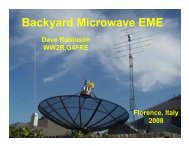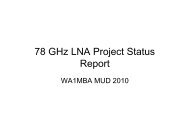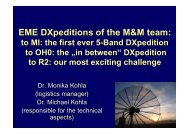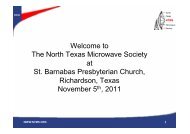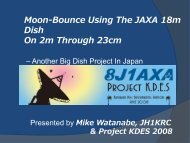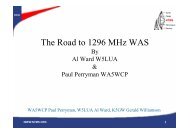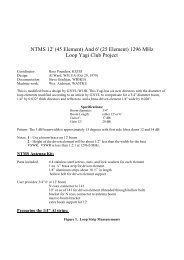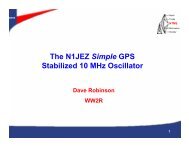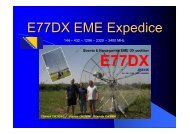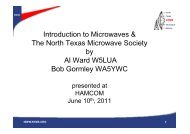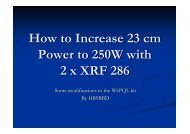W1GHZ - Parabolic Dish Focus, Zom and Tilt - NTMS
W1GHZ - Parabolic Dish Focus, Zom and Tilt - NTMS
W1GHZ - Parabolic Dish Focus, Zom and Tilt - NTMS
You also want an ePaper? Increase the reach of your titles
YUMPU automatically turns print PDFs into web optimized ePapers that Google loves.
<strong>Parabolic</strong> <strong>Dish</strong><br />
<strong>Focus</strong>, Zoom<br />
<strong>and</strong> <strong>Tilt</strong><br />
Paul Wade<br />
<strong>W1GHZ</strong>
EME Prevention<br />
• TREES – no window
Solution – new QTH
Clear View
<strong>Dish</strong> Pattern Simulation<br />
• Ansoft HFSS<br />
• More detail than<br />
measurement<br />
• No reflections<br />
• See affect of<br />
focus, zoom, <strong>and</strong><br />
tilt<br />
15<strong>Dish</strong>,<br />
Coffee-can feed
Better<br />
Feed<br />
• More gain<br />
• Smaller<br />
sidelobes<br />
• Same<br />
beamwidth<br />
15<strong>Dish</strong>,<br />
Super-VE4MA feed
<strong>Dish</strong> <strong>Focus</strong>
0.25Closer to Reflector
0.5Closer to Reflector
0.75Closer to Reflector
1Closer to Reflector
1.25Closer to Reflector
1.5Closer to Reflector
1.75Closer to Reflector
2Closer to Reflector
2.5Closer to Reflector
3Closer to Reflector
Plot the gain vs focus shift<br />
35<br />
<strong>Dish</strong> with Axial Feed Displacement<br />
30<br />
25<br />
Gain (dBi)<br />
20<br />
15<br />
10<br />
Super VE4MA<br />
Coffee-can<br />
5<br />
0<br />
-5<br />
-3 -2 -1 0 1 2 3<br />
Feed Aperture Position in Wavelengths from <strong>Dish</strong> Focal Point
Axial Defocusing Loss
<strong>Focus</strong> Summary<br />
• As Feed moves toward reflector, pattern<br />
gets wider, gain decreases (Conservation<br />
of Energy)<br />
• Other direction similar<br />
• <strong>Focus</strong> is critical for deep dish<br />
– ¼ error = ~1dB<br />
– For any diameter dish
How to focus accurately<br />
• Range > 50x Rayleigh Distance (Imbriale)<br />
– Not practical for EME dish<br />
• Sun Noise<br />
• Celestial Sources (Larger dishes)
Practical <strong>Focus</strong> Error<br />
• Normal antenna range ~= Rayleigh Distance<br />
• <strong>Focus</strong> at infinity = measured gain ~1 dB low<br />
• <strong>Focus</strong> on range = real gain ~ 1 dB low<br />
– Feed will be too far from reflector<br />
> <strong>Focus</strong> at 5x Rayleigh Distance = tiny error
<strong>Focus</strong> for BIG <strong>Dish</strong>
Offset <strong>Dish</strong><br />
18 inch DSS <strong>Dish</strong>,<br />
W2IMU dual-mode feed<br />
15.7 wavelengths
Better<br />
Feed<br />
• More gain<br />
• Smaller<br />
sidelobes<br />
• Same<br />
beamwidth<br />
18 inch DSS <strong>Dish</strong>,<br />
Skobelev optimized<br />
dual-mode feed
Feed 0.83closer to reflector<br />
uptilt
Feed 1.66closer to reflector<br />
uptilt
Feed 0.83away from reflector<br />
downtilt
Offset <strong>Dish</strong> <strong>Focus</strong> Shift<br />
• Axial feed shift tilts pattern<br />
– Closer tilts up<br />
– Away tilts down<br />
• Maximum gain – only small decrease<br />
• Axial gain – decrease due to pattern tilt
Lateral Feed Shift<br />
• Beam Scanning<br />
• Multiple feeds – several b<strong>and</strong>s<br />
• Lateral Feed shift causes beam shift in<br />
opposite direction
Lateral Feed Shift - <strong>Focus</strong><br />
• Shifted <strong>Focus</strong> follows Petzval Surface<br />
– Parabola with ½ radius of curvature<br />
– Tangent to focal plane at focus<br />
• Shifted <strong>Focus</strong> farther away from reflector<br />
• Adjust for Maximum Gain
Shift - Maximum Gain Contour
Scanning Limit (1 dB Loss)
Feed-scanning Loss
Feed Pointing<br />
Straight<br />
Ahead<br />
Best
Zoom Control<br />
• Move feed in or out to broaden pattern<br />
• Easier to find signals<br />
• BUT<br />
• Maximum beamwidth increase ~3 times<br />
• Gain ~10 dB lower at 3X beamwidth<br />
• Gain never higher anywhere than focused<br />
• So zoom only finds strong signals<br />
• Small shift can fill in null around main beam
Alternative to Zoom<br />
• Align bearing accurately<br />
– Beacon<br />
– Sun<br />
– Compass<br />
• Know your pattern<br />
• Search by ½ beamwidth<br />
– For 4 degree beam, move in 2 degree steps
<strong>Tilt</strong><br />
• A few degrees uptilt can enhance<br />
terrestrial signals<br />
• More for rain scatter<br />
• Offset zoom = tilt<br />
– Bad idea – no intuitive reference for level
RV tilt gauge good for dishes
Summary<br />
• Accurate focus is important, especially for<br />
deep dishes<br />
• Sun noise or celestial source needed for<br />
accurate focus<br />
• Lateral shifted feed adjusted independently<br />
• Zoom has little benefit<br />
• <strong>Tilt</strong> is useful, best done mechanically<br />
• Location of dish is important<br />
• www.w1ghz.org
<strong>W1GHZ</strong> --> Vermont



